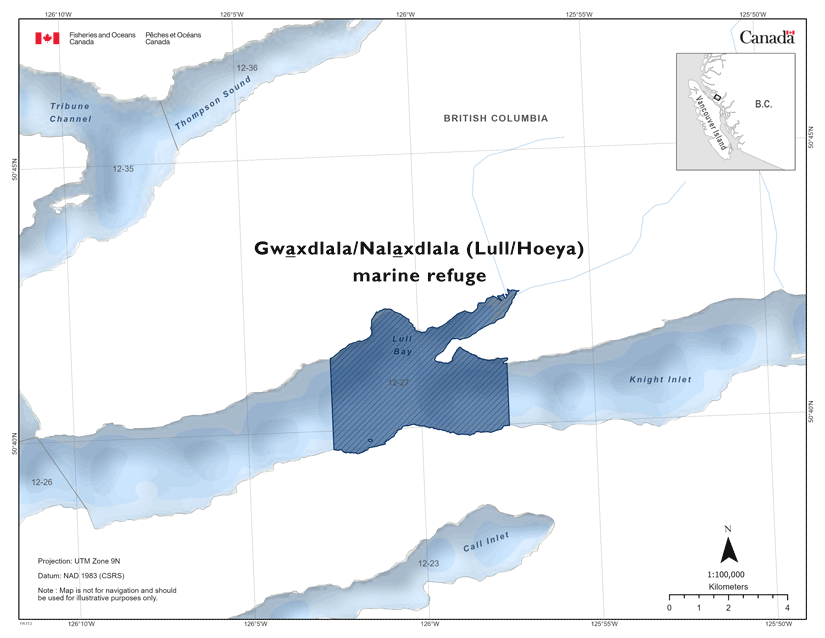Gwa̲xdlala/Nala̲xdlala (Lull/Hoeya) marine refuge
- Location
- Northern Shelf Bioregion (British Columbia)
- Approximate size (km²) contribution to Marine Conservation Targets
- 21.4 km²
- Approximate % coverage contribution to Marine Conservation Targets
- <0.01%
- Conservation objective
- Protect corals and sponges and contribute to long-term conservation and species biodiversity
Ecological components of interest
Species of regional importance: Corals, sponges, rockfish and salmon
- Why it is important: Unique geomorphological and oceanographic features contribute to the significance of the site and to the presence of high biodiversity and rare species including delicate gorgonian corals normally found at much greater depths.
Habitat that is important to biodiversity conservation: Unique shallow sill coral and sponge gardens, estuaries, eelgrass beds and kelp forests
- Why it is important: This site contains a unique shallow sill with sensitive and unique coral and sponge garden habitat. The sill and adjacent sound provide refuge habitat for many ecologically and commercially important finfish and shellfish species including rockfish, salmon, crab and prawns. These features were identified as a Sensitive Benthic Area (SBA) and recommended as an Ecologically and Biologically Significant Area (EBSA).
Prohibitions
The ecological components of interest are effectively conserved through the following prohibitions:
- No commercial, recreational or Food, Social and Ceremonial fishing activities are allowed within the areas indicated on the map.
Other considerations
No human activities that are incompatible with the conservation of the ecological components of interest may occur or be foreseeable within the area.
Environmental context
Coral fans can form dense thickets that provide important vertical refuge for fish species. These cold-water corals are fragile and can be damaged by bottom-contacting fishing methods. Other features, such as eelgrass beds and kelp forests, provide refuge, habitat, food and nursery grounds for aquatic species.
The shallow sill represents a remarkable and exceptional habitat on the British Columbia coast. Unique geomorphological, oceanographic and biotic characteristics at the site create atypical risk to ecologically vulnerable organisms from all fishing gear types.
Prohibition of all fishing protects the fragile coral structures, eelgrass beds and kelp forests. They can also protect the services (e.g., refuge, habitat, food and nursery areas) that these structures provide to many aquatic species that use the pelagic and benthic areas, including rockfish, salmon, crabs and prawns.
- Date modified:
